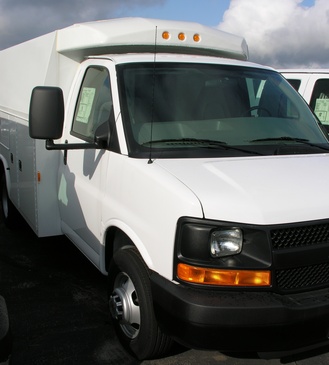
The longer a tube or rod gets, the more it twists. That's just one of those fundamental rules of engineering. If you want to reduce twist in a shaft, you've got three basic options: use stronger material, use thicker material or a thicker shaft, or use a shorter shaft. Many truck manufacturers and performance vehicle manufacturers choose the latter option, particularly since it allows for the use of an isolator "puck" in the middle of the shaft, reducing noise, vibration and shock to the transmission. The center carrier bearing holds the middle of this now-flexible shaft up and against the bottom of the vehicle.
Use a jack to raise the vehicle high enough to allow you to get under it with room to work with your tools.
Place the vehicle on jack stands positioned precisely under the axle or frame rather than having it supported by the jack.
Hang a work light under the vehicle so you can see what you're doing.
Draw a reference mark on the side of the transmission using a piece of chalk, continuing onto the drive shaft which will help you reposition the shaft exactly as it was when you reinstall it. Drive shafts connect into transmissions with a splined shaft which will only fit in one way, but the index mark will help you find that exact position when reinstalling the shaft.
Mark the universal joint with chalk where it attaches to the yoke coming out of the rear axle differential so it can be reinstalled exactly as it was when the drive shaft was removed.
Reference-mark the plates which connect the forward portion of the drive shaft and the rear portion of the drive shaft so they can be reinstalled exactly as they were originally installed.
Disconnect the drive shaft center bearing from the vehicle’s frame using the appropriate sized socket and wrench. On some vehicles the bearing block bolts thread into nuts which are welded to the frame; on other vehicles, the block is bolted to the frame with a standard, two part bolts and nuts.
Remove the bolts which secure the universal joint bearing to the yoke coming out of the rear axle differential.
Wrap and secure a strip of duct tape around the caps of the universal joint bearing to prevent the caps from falling off while you are handling the drive shaft.
Pull the entire drive shaft to the rear extracting the splined shaft from the rear of the transmission. Once it’s free, move the drive shaft to a workbench.
Spin the bolts from the plates which connect the front part of the drive shaft to the rear portion of the drive shaft. Set the rear portion of the drive shaft aside. Secure the forward portion of the drive shaft firmly in a vise.
Unscrew the center nut which holds the front connecting plate onto the shaft on which the center bearing is positioned.
Tap the old center bearing off the shaft with a hammer. If you need to direct the blows to the where the collar of the bearing touches the shaft, use a brass-ended punch to prevent nicking or scratching the shaft.
Apply a thin layer of grease on the bearing shaft to make the new bearing slide on more easily.
Push the bearing onto the shaft to get it started, then use a hammer to force it all the way into position. Use a brass-ended punch if you need to strike the bearing hard; direct blows could scratch or nick the bearing collar or the shaft.
Reassemble the drive shaft, then reinstall it onto the vehicle by reversing the removal proceedure. Use the index marks to insure it’s reattached exactly as it was before it was removed.